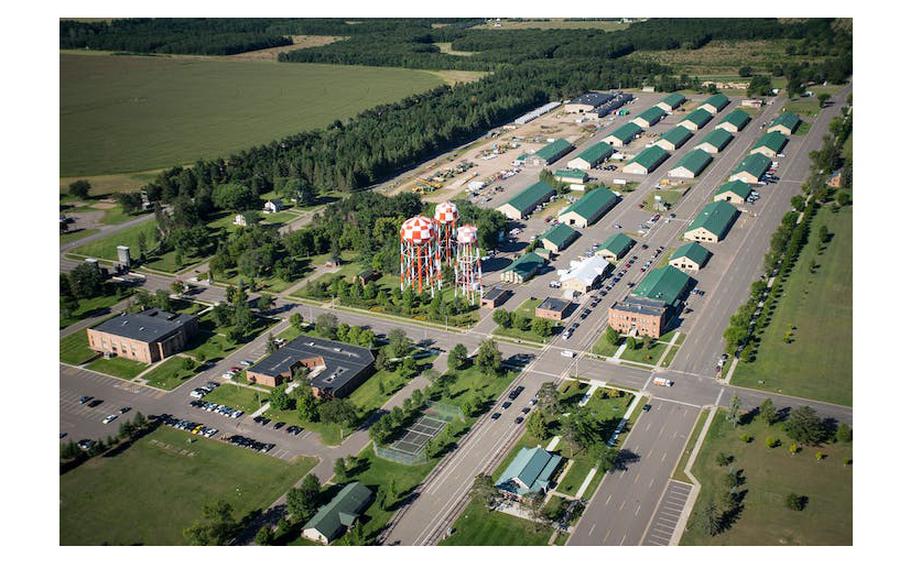
Camp Ripley in Little Falls, seen in 2015, is one of two military sites in Minnesota known to have contaminated nearby drinking water wells with PFAS. (Aaron Lavinsky/TNS)
(Tribune News Service) — The Department of Defense is investigating six sites in Minnesota for contamination from PFAS chemicals — and the toxic contaminants have been found in drinking water wells near military installations in Duluth and Little Falls.
PFAS, short for per- and polyfluoroalkyl substances, are a class of thousands of industrial chemicals that don’t break down in the environment and can build up in human bodies over time. The chemicals have been linked to reproductive problems and some cancers.
In the case of military sites and airports, the chemicals were used in firefighting foams that were often repeatedly sprayed during training exercises. The military announced this year it would stop using PFAS foams in all situations by 2024.
Now, DOD is gradually testing every military site where the foams have been used. In a report to Congress last month, the department wrote that underground PFAS plumes are close to drinking water supplies in 245 of the 275 locations where it has active investigations. The report did not specify which sites.
Jared Hayes, a senior policy analyst with the nonprofit Environmental Working Group, said the defense department has only just begun to model how groundwater is moving under those 245 locations.
For those nearby waiting for definitive answers on whether the military tainted their wells, “it could be some time. It could be a couple years in some cases,” he said.
Sites targeted for investigation in Minnesota
• Minneapolis-St. Paul International Airport.
• Minneapolis-St. Paul Air Reserve Station.
• Holman Field Army Air Reserve Support Station in St. Paul.
• The former Twin Cities Army Ammunition Plant in Arden Hills.
• Minnesota National Guard’s Camp Ripley, in Little Falls.
• Duluth International Airport.
The ammunition plant is already a Superfund site with known groundwater contamination. The Environmental Protection Agency said in 2019 that the soil at the sprawling 2,370-acre property had been properly cleaned, however, paving the way for potential redevelopment.
The two locations on the list that are suspected to have leached PFAS into nearby drinking water wells are Camp Ripley and the Duluth Airport, according to Amy Barrett, a spokeswoman for the Minnesota Department of Health. “The rest are in areas where private wells are unlikely to be used for drinking water,” she wrote in an email.
Right now, the military is only replacing water supplies for locations where the combination of PFOA and PFOS, two of the oldest PFAS chemicals, exceeds 70 parts per trillion, according to Capt. William Hermanson, a spokesman for Camp Ripley. Only one of 30 sites being tested around the National Guard camp has tested that high, and temporary filtration was installed there, he said.
But the 70 parts per trillion level is an old health guideline set by EPA. The agency is now proposing enforceable limits at much lower levels for a group of PFAS chemicals. For PFOA and PFOS, the two best-studied chemicals, EPA said the limits should now be just 4 parts per trillion — essentially the smallest amount currently detectable.
Minnesota also has its own drinking water limits for the chemicals. The Minnesota Pollution Control Agency has provided either filtration or bottled water at homes when test results exceed the state’s standards but not the defense department limit. That includes two homes near the Duluth airport, and two homes outside of Camp Ripley, MPCA spokeswoman Andrea Cournoyer wrote in an email.
A well at a third home outside of Camp Ripley also tested above state levels, though it was not being used for drinking water, Cournoyer said. Two commercial properties near the camp also exceeded state levels.
Many states do not have their own PFAS rules, so the Pentagon’s standard is the only one in place. As a result, families or businesses “might not be getting alternative drinking water, and still be drinking contaminated water,” Hayes said.
©2023 StarTribune.
Visit startribune.com
Distributed by Tribune Content Agency, LLC.